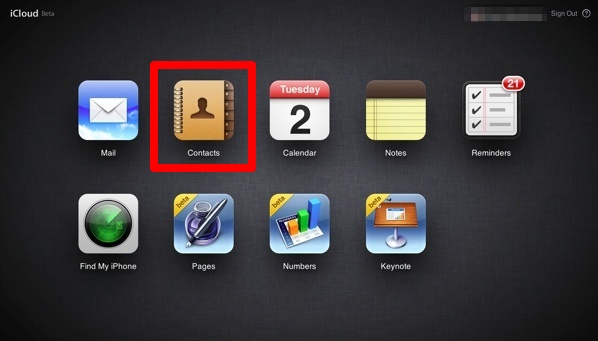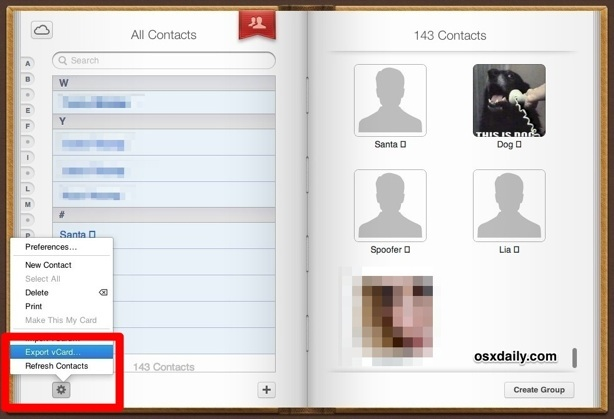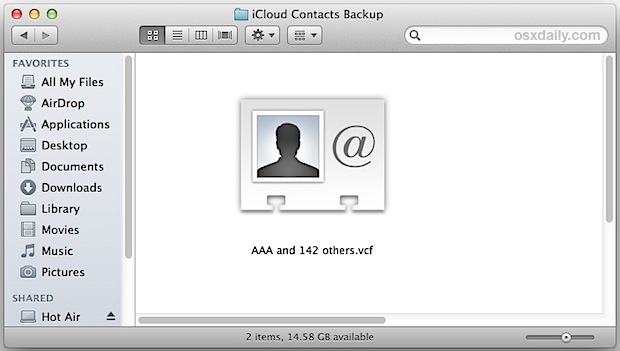Export iPhone Contacts the Easy Way with iCloud
![]() As you probably know, all of your iPhone Contacts and related address book information is stored within iCloud, assuming you use the cloud service to sync and backup your data of course.
As you probably know, all of your iPhone Contacts and related address book information is stored within iCloud, assuming you use the cloud service to sync and backup your data of course.
What many people don’t know, is that the web interface of iCloud provides an incredibly simple method of exporting those same iPhone contacts, giving you easy access to individual contacts in the address book, or even the ability to export and save the entire contacts list itself – all directly from the web, with or without the iPhone itself.
How to Export All Contacts from iPhone via iCloud
This little known feature is infinitely helpful and extremely easy to use. We’ve broken it down into three easy steps; accessing the Contacts, then exporting either a single contact, or the complete set of contact data. Once you have it all saved, you can do whatever you want with it.
1: Log into iCloud and View the Contacts
- Go to iCloud.com and log in using the same Apple ID that your iPhone, Mac, iOS devices is attached to
- Click on “Contacts”

The iCloud web interface contains your entire contact list and all address book data. This contacts list should be up to date so long as iCloud is enabled to sync Contacts, and unlike the rest of iCloud data it does not depend on backups to update or be maintained. Nonetheless, there can be an occasional delay with updating information from different devices through iCloud, but it can be forced to update immediately by initiating a backup to iCloud. After that has finished, click the gear icon in the Contacts web-app and choose “Refresh Contacts” to have the list repopulate iCloud Contacts with the new/updated address information.
Once you’re logged into iCloud and in the Contacts section, you can now export either a single contact, a group of contacts, or the entire contact list. Each is saved as a VCF (VCard), which is a universally accepted format for address book data that works across virtually all platforms, from iOS, Mac OS X, Windows, Android, Blackberry, etc.
2: Export a Single Contact
- Search for the contact information you wish to export and select their name from the list
- Click the gear icon then choose “Export Vcard”
- Look in the ~/Downloads/ directory for the saved card

You can also send individual contacts directly from an iPhone through the Contacts app, but the iCloud web method insures you will still have access to contacts even if the phone is dead, lost, or just not nearby at the moment.
Multiple contacts can exported together by selecting more than one contact and then using the same Export function, or you can go with the next approach which will export the entire contact list.
3: Export & Save the Entire iPhone Contacts List from iCloud
- Select ALL contacts by hitting Command+A, or by clicking the gear icon then choosing “Select All”
- Click the gear icon then choose “Export VCard”
- Find the saved .vcf vcard file in the Downloads directory

The resulting VCF file is literally the entire address book, and it can be a few megabytes in size if you have a sizable address book. Here is what it might look like in the Finder:

Now that the contacts list has been exported, you can save it somewhere as a backup, or quickly share it list with someone else just by emailing that entire vcf file to another individual (or yourself), which can then be imported directly to an iPhone or iPad, Android, Windows Phone, or Blackberry. Just about everything can use the vcf file, so it’s unlikely to run into any problems using it regardless of the platform.
Being able to access contacts from quite literally anywhere with web access, plus export either a single contact, a group of contacts, or the entire address book, is one of many reasons why you should be sure to use iCloud, not only for regular iOS data backups but also specifically for iPhone Contacts. This ease of data portability is simply invaluable, and you’ll never be without important address information again, even if you don’t have the iPhone anymore because it has been misplaced, lost, stolen, or even just because the battery died.


i connect to icloud succesfully but when i select all contacts and export them the downlods will not starts.
what can i do…,…..,
This would be great, if it worked. You have missed a step where after… Click the gear icon then choose “Export VCard”
… you haven’t said whether to select ‘open with’ or ‘save file’.
I have tried both and neither works. It saves the file as a Lotus Notes file (as this is my default email system) however I want to export as a csv file. How do I do that???
You’re exporting the VCF file, so you would choose to “Save” the file, not open it. Open would be like importing.